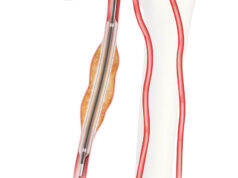This advertorial is sponsored by Cardionovum®

Matteo Tozzi (Varese, Italy) recently spoke to Vascular News about the role of drug-coated balloons (DCBs) in vascular access.
The Aperto® over-the-wire (OTW) DCB from Cardionovum—which is available in lengths of 20, 40 and 60mm and diameters from 4 up to 12mm—was developed specifically to solve unmet clinical needs in the treatment of haemodialysis access stenosis and recanalisation of arteriovenous fistula shunt grafts.
Tozzi, who is a full professor of vascular surgery at the University of Insubria, started using the Aperto in his vascular access practice over 10 years ago and is planning to soon publish his clinical experience in a study called Aperto 600.
Today, Tozzi explained, there is a pressing need for a device such as the Aperto. Haemodialysis patients now survive far longer than they used to, and therefore the key goal at present is to maintain patency of the access circuit to ensure that it can be used for several procedures over a long period of time.
“This goal has been achieved,” Tozzi reported, attributing this result to the Aperto. In his clinical practice, Tozzi shared that patients have a patent vascular access circuit without restenosis at one year after DCB treatment in the vast majority of cases.
Previously, Tozzi said, by way of comparison, treatment was limited to percutaneous transluminal angioplasty (PTA) alone, which at his centre resulted in no patients having a patent vascular access circuit at one year. The results with DCB, however, are “incredible”.
Tozzi was keen to stress that DCB is not the “final cure” for intimal hyperplasia. However, he underlined the importance of focusing on what the treatment option does offer in this regard. Significantly, he said, Aperto results in the mean time from first to second treatment being extended, with the average time in his centre now being eight months and only 6% of patients undergoing two or more procedures over the course of a year. “This is important for the patients, because it means less time in hospital,” Tozzi commented.
While the efficacy of DCBs has been proven to be superior to that of PTA for these patients, there are limited data on their economic benefit. To rectify this, Tozzi noted that he has started a collaboration that aims to assess the cost benefit of DCBs in the vascular access failure population using the data coming from his Aperto 600 study combined with data from a metaanalysis of the available literature. The study looked at PTA alone compared to PTA with DCB.
He described the preliminary results from this economic analysis as positive, citing less time in hospital and less money spent on procedures, leaving more space in hospital to treat new patients and providing an opportunity to reduce waiting lists. “It is important to have the correct allocation of money and resources, so that we can treat more patients with less money,” he remarked.
Finally, Tozzi looked ahead to future guidelines regarding vascular access in haemodialysis patients. He highlighted the fact that the evidence base for DCBs continues to grow, and that the scientific community is waiting for this treatment option to be added to existing recommendations.
Tozzi concluded that, in his opinion, DCBs should now be viewed as a “first-line” treatment for stenosis and vascular access failure in haemodialysis patients.
Disclaimer
The efficacy and safety of these products have not been confirmed by US Food and Drug Administration (FDA)-approved research.













